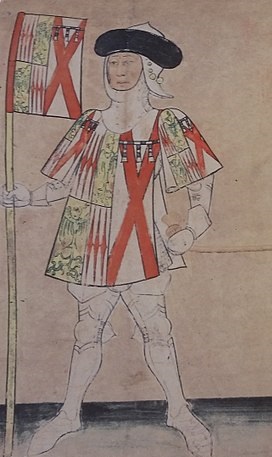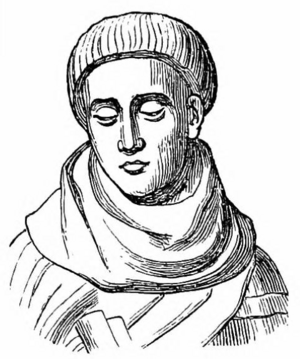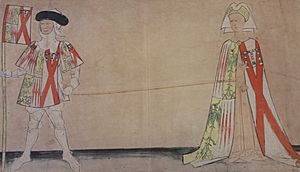Richard Neville, 5th Earl of Salisbury facts for kids
Quick facts for kids
Richard Neville
Earl of Salisbury
|
|
|---|---|

Richard Neville, 5th Earl of Salisbury, shown in a drawing from the 1480s.
|
|
| Born | 1400 |
| Died | 31 December 1460 (aged 60) |
| Cause of death | Beheaded |
| Resting place | Bisham Priory, Berkshire |
| Spouse(s) | Alice Montagu, 5th Countess of Salisbury |
| Children |
|
| Parents |
|
| Family | Neville |
Richard Neville, 5th Earl of Salisbury (born 1400 – died December 31, 1460), was an important English nobleman. He lived in northern England and became a strong supporter of the House of York. This was during the early years of the Wars of the Roses, a series of civil wars in England. Richard Neville was also the father of Richard Neville, 16th Earl of Warwick, who was famously known as the "Kingmaker".
Contents
Who Was Richard Neville?
Richard Neville was born in 1400 at Raby Castle in County Durham. He was the third son of Ralph de Neville, 1st Earl of Westmorland. His mother was Joan Beaufort. Joan was the daughter of John of Gaunt, 1st Duke of Lancaster, who was a son of King Edward III. This made Richard Neville part of a very important family.
The Neville family owned a lot of land in County Durham and Yorkshire. Kings like Richard II and Henry IV found the Nevilles useful. They helped balance the power of another strong family, the Percys, near the border with Scotland. Because of this, Richard's father was made an Earl in 1397. He also became a "Warden of the West March," which meant he was in charge of defending the western border with Scotland.
His mother, Joan Beaufort, was a granddaughter of King Edward III. This marriage showed how important the Neville family had become. Richard's sisters also married into very powerful families. His youngest sister, Cecily, married Richard, Duke of York.
Richard's Important Marriage
Richard Neville married Alice Montagu. She was the daughter and only heir of Thomas Montagu, 4th Earl of Salisbury. We don't know the exact date of their wedding. But they were already married by February 1421. They attended the coronation of Queen Catherine of Valois together.
When Thomas Montagu died in 1428, Richard Neville and Alice officially became the Earl and Countess of Salisbury. This marriage gave Richard more land and wealth than he might have expected as a younger son. He gained important Neville family lands like Middleham and Sheriff Hutton. He also got Penrith. Only Raby Castle, the oldest family home, went to his older half-brother's family.
This led to a family disagreement, known as the Neville–Neville feud. It later became part of a bigger fight between the Neville and Percy families.
Protecting the Scottish Border
The border with Scotland was protected by two "Wardens." One was for the East March and the other for the West March. The Percy family used to hold these important jobs. But after the Percy family rebelled, Richard's father, Ralph Neville, took over as Warden of both Marches.
Richard Neville became a knight and was named Warden of the West March in 1420. This was a very valuable job. It was worth a lot of money, especially if there was a war with Scotland. Even in peacetime, it allowed him to have many trained soldiers ready. Richard was highly trusted by King Henry V. He was also made a Justice of the Peace in several areas.
In 1431, he traveled with the young King Henry VI to France for his coronation. When he returned, he became Warden of the East March. He later resigned from these roles in 1436. This might have been to get the King to pay him money that was owed. After his resignation was accepted, he went to France with Richard, Duke of York. He returned the next year and joined the King's Council.
He took up the Wardenship of the West March again in 1443. Even though he was paid less, the money was now guaranteed. He was also honored as a Knight of the Order of the Garter in 1436. The next year, he became a member of the King's Council.
Neville Family vs. Percy Family
By the end of 1443, Richard Neville was in a strong position. He was part of the King's Council and Warden of the West March. His brother, Robert Neville, was the Bishop of Durham. Another brother, William Neville, 1st Earl of Kent, was in charge of Roxburgh Castle. Richard had seven children, and his two oldest, Cicely and Richard, made excellent marriages.
However, the King, Henry VI, started to favor his own close relatives more. Richard Neville was only related through a distant family line. This meant that the local rivalry between the Nevilles and the Percys in northern England became more serious. A strong king could control such fights. But a weak king might see them grow into bigger conflicts.
The Percy family had lands all over northern England. The Neville family's lands were mainly in north Yorkshire and County Durham. As Warden of the West March, Richard Neville had a lot of power in the northwest. The Percys were unhappy because Richard was recruiting their tenants (people who lived on their land) to work for him. Richard had more money to spend than the Percy leader, Northumberland, who hadn't been paid for his own Warden role in years.
In the 1400s, it was common for powerful lords to have "retained men." These men would promise military support to a lord. In return, the lord would pay them a small fee, give them a special badge, and help them in their disagreements with neighbors. Northern England was far from London, so getting quick legal help was difficult. Richard Neville, with his wealth as Warden, could offer better support to people than Northumberland could.
In 1448, during a war with Scotland, Northumberland led his forces through Richard Neville's West March. This was a big insult. Northumberland was defeated, and his son was captured. Richard Neville lost many horses trying to help. He was then left out of the peace talks. This made relations between the two families even worse.
Northumberland's second son, Thomas Percy, Lord Egremont, caused more trouble in Yorkshire. On August 24, 1453, Lord Egremont gathered about 1,000 men. He planned to attack Richard Neville and his family near York. Richard Neville was returning from his son's wedding. Even though his group was smaller, they were better armed. Richard and his men fought back and reached their castle safely. This event started what was almost a private war between the families.
Richard Neville and the Duke of York
Richard Neville changed his loyalty to Richard, Duke of York. In 1455, the Duke of York made Richard Neville the Lord Chancellor. This important job allowed Richard Neville to help his supporters against the Percys.
When King Henry VI tried to rule on his own and remove the Duke of York from power, Richard Neville joined the Duke. They fought at the First Battle of St Albans. Richard Neville said he was just acting in self-defense. In 1458, he took part in "The Love Day," an attempt to make peace in London.
He was very successful in the Battle of Blore Heath. But after the Duke of York's army fell apart at the Rout of Ludford Bridge, Richard Neville escaped to Calais. He was specifically excluded from any royal pardon. He returned to England with the Duke of York in 1460.
Richard Neville was killed on December 30 or 31, 1460. This was the night after the Battle of Wakefield.
Death and Burial
After the Yorkists lost the Battle of Wakefield, Richard Neville escaped the fighting. But he was captured during the night. He was taken to the Lancastrian camp. Even though he was very wealthy, and the nobles might have let him pay a ransom, he was dragged out of Pontefract Castle. He was then beheaded by the local people. He had been a very strict lord to them.
He was first buried at Pontefract. Later, his sons moved his body to the family burial place at Bisham Priory in Berkshire. They built a monument there to remember him. A statue from this monument was later moved to St Mary's Church at Burghfield.
Family and Children
Richard Neville married Alice Montacute, 5th Countess of Salisbury (1407-1462). She was the daughter of Thomas Montacute, 4th Earl of Salisbury. They had twelve children together:
Sons
- Richard Neville, 16th Earl of Warwick (1428–1471), known as "The Kingmaker." He was the oldest son and inherited his father's titles. He married Anne Beauchamp, 16th Countess of Warwick.
- Sir Thomas Neville (around 1429–1460). He became a knight in 1449 and died at the Battle of Wakefield.
- John Neville, 1st Marquess of Montagu (around 1431–1471). He married Isabel Ingaldesthorpe.
- George Neville (1432–1476). He became the Archbishop of York and also the Chancellor of England.
- Ralph Neville (born around 1440), who died as a baby.
- Robert Neville (born around 1446), who also died as a baby.
Daughters
- Joan Neville (around 1424–1462). She married William FitzAlan, 16th Earl of Arundel.
- Cecily Neville (around 1425–1450). She married Henry Beauchamp, 1st Duke of Warwick.
- Alice Neville (around 1430–1503). She married Henry FitzHugh, 5th Baron FitzHugh. Her granddaughter was the great-grandmother of Catherine Parr, who was one of King Henry VIII's wives.
- Eleanor Neville (around 1438–before 1472). She married Thomas Stanley, 1st Earl of Derby.
- Katherine Neville (1442–1504). She married William Bonville, 6th Baron Harington first, and then William Hastings, 1st Baron Hastings.
- Margaret Neville (around 1444–1506). She married John de Vere, 13th Earl of Oxford.
Images for kids







